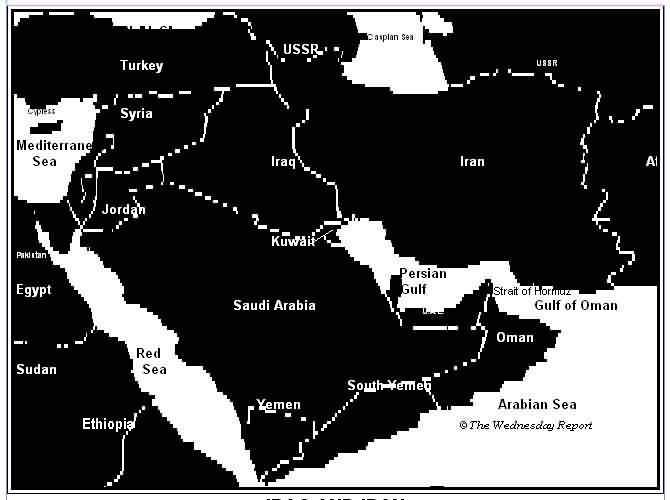![]() Home | Back to TWR Index | Email | The Editor | History | Gulf War
Index
Home | Back to TWR Index | Email | The Editor | History | Gulf War
Index
Special Report: Iraqi Aggression and the Politics of the Arab World

![]()
Volume 4, Number 35 August 29, 1990
He has detained as hostages the diplomats and workers of numerous nations and used their children in an atrocious psychological manipulation of the peoples of western nations. He has wreaked dread upon innocents by threatening acts of terrorism the world over. His adventurism threatens to take control of the Middle East, choking the flow of petroleum energy, promoting automobile fuel prices climbing to $1.00 per litre, right here in Canada.
Singly, these charges would fetch scorn. In aggregate they invite, perhaps compel the dismantling of this dictator's criminal regime.
On its present course, if unchecked, Iraq in this decade would become a nuclear power with expanded territory including Kuwait, Saudi Arabia, Jordan, and more. Israel would be destroyed at the hand of Saddam Hussein, a man who does not issue idle threats. He has promised to murder "half of" Israel's population thus removing what he calls a "Zionist Invasion". Baghdad would control the world economy and decide at will when North America would have recession, depression, inflation and chaos — all of this achieved through the most heinous infraction of human rights using in cavalier fashion every dread of living history: nuclear, biological, and chemical (NBC) weapons.
George Bush and Maggie Thatcher know that if the world does not deal with its problem now it will be faced with greater danger at a later time when its combative means may not be so potent.
From "Operation Desert Shield" the Pentagon in Washington has already learned the hard way that it does not have enough C-5 Galaxys; that North American sealift capacity is insufficient; and that in this, the largest emergency deployment of U.S. forces since WW II, there is no easy way to move M1A1 tanks and other heavy armour.
Today, logistics alone prevent the U.S. from undertaking a preemptive strike against Iraq and temporarily limit U.S. forces to a defensive role.
As if biding his time, U.S. President Bush seems to patiently endure the psychological war fare Saddam has engaged against the world.
Comment:
IS WAR INEVITABLE?
Saddam Hussein's dangerous regime is too great to ignore. His country holds stockpiles of hideous chemical weapons and has or will soon have "The Bomb". Saddam has threatened use of chemical weapons against all opponents and past crimes leave no doubt that his threat is real. He has invaded a sovereign Arab nation, Kuwait, plundering its beauty and its wealth, raping its women, seizing homes, releasing inmates of Kuwait's jails and mental asylums, and robbing the Kuwaitis of their right to self determination. And his track record shows that he is capable of anything.
The impressive advancement of Iraqi scientists in a quest for mass destruction weapons; rapid progress in ballistic missile technology; undying pursuit of long range artillery development; advanced research into biological warfare agents; the continued growth of Iraq's million-plus troops; an Iraqi defence budget comprising 20 percent of the country's GDP; conspicuous support of terrorism; and rumours about misbegotten Soviet tactical nuclear weapons; coupled with Saddam's propensity for bloodshed using any new "toy" he can lay his hands on, all point to a nation readying for boundless aggression — a world of trouble.
Saddam will not just go away. Impervious to challenge he continues to irradicate the balancing counter-views of internal political opponents.
